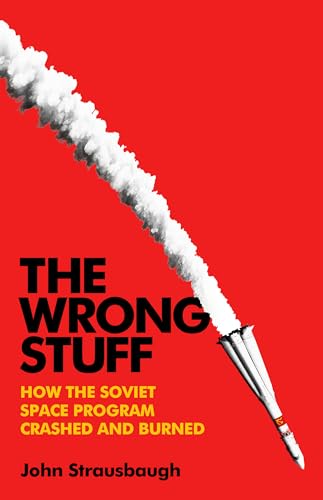What do you think?
Rate this book


272 pages, Hardcover
Published June 4, 2024
One thing was obvious from the get-go: the author, John Strausbaugh, is no fan of the Soviets, or Communism in general. Great! Neither am I. As (even) the cover and the title indicate, this is a warts-and-all look at the history of the Soviet space program. And it turns out to be mostly warts.
It's been a few years since I read Stephen Walker's , a history of the events leading up to and including Yuri Gagarin's slightly-under-one-orbit flight in April 1961. Safe to say that Strausbaugh's take is less respectful, less academic (no index or endnotes), and more of a (somewhat guilty) pleasure to read.
We know that the Soviets had their share of space disasters, notably (killing Vladimir Komarov) and (killing Georgy Dobrovolsky, Vladislav Volkov, and Viktor Patsayev). Strausbaugh goes into the gritty details of those failures. But, as he tells the whole story, it's pretty amazing that the body count isn't much higher; the Soviets were very slapdash, explicitly trading off cosmonaut safety against scoring propaganda victories. Example: Gagarin's flight was nearly a disaster due to the failure of his Vostok's reentry module to cleanly separate from its service module. This was a continuing problem with the Vostoks, and continued into the Soyuz spacecrafts.
The book might be a little slapdash itself. Page 107 puts the Apollo 1 disaster (which killed astronauts Gus Grissom, Roger Chaffee, and Ed White) in 1963. (It was 1967.) Strausbaugh knows better, and he gets it right later in the book, but (come on) a light fact-check would have caught this.
In other spots, gratuitous and strained US/USSR comparisons are made. Gagarin's post-flight parade placed him and Nikita Khrushchev "in a convertible Zil with the top down, like the Kennedys in Dallas." Wha‚Ä�?
Strausbaugh does a good job of giving the Soviets personalities, not always complimentary ones. After his flight, Gagarin mishandled his fame, turning into a drunk and a womanizer. His friend/rival Gherman Titov, also succumbed. The famous "chief designer", Sergei Korolev, suffered in Stalin's Gulag for six years before his "meteoric" success in getting the space program off the ground. But he failed dismally in his design of the , a rough equivalent to the American Saturn V. It never worked, blowing up a lot.
Strausbaugh does pay some respect to Cosmonaut Alexei Leonov, who might be the closest to Tom Wolfe's famous "Right Stuff". He nearly got killed doing a spacewalk stunt (an impromptu effort to upstage Ed White's upcoming Gemini EVA); he got along famously with his American counterparts during the planning and execution of the Apollo-Soyuz stunt mission.
The Soviets were also notoriously secretive, which caused a lot of speculation they were covering up some cosmonaut deaths. One of the rumor-mongers was Pun Salad fave, Robert A. Heinlein, who penned an article for American Mercury recounting his trip to the USSR with his wife, Virginia; he reported rumors that the May 15, 1960 flight of , the first test flight of the Vostok craft, was actually manned. Nope.
In short, an entertaining read, guaranteed to wipe away any misty watercolor memories of the way the Soviets were. You'd never know from reading it, however, that the American astronaut body count is much higher than Russia's. NASA is also a socialist enterprise, and its safety tradeoffs were merely different in details.